Mateo Espinosa Zarlenga
Addressing Concept Mislabeling in Concept Bottleneck Models Through Preference Optimization
Apr 25, 2025Abstract:Concept Bottleneck Models (CBMs) propose to enhance the trustworthiness of AI systems by constraining their decisions on a set of human understandable concepts. However, CBMs typically assume that datasets contains accurate concept labels an assumption often violated in practice, which we show can significantly degrade performance (by 25% in some cases). To address this, we introduce the Concept Preference Optimization (CPO) objective, a new loss function based on Direct Preference Optimization, which effectively mitigates the negative impact of concept mislabeling on CBM performance. We provide an analysis on some key properties of the CPO objective showing it directly optimizes for the concept's posterior distribution, and contrast it against Binary Cross Entropy (BCE) where we show CPO is inherently less sensitive to concept noise. We empirically confirm our analysis finding that CPO consistently outperforms BCE in three real world datasets with and without added label noise.
Avoiding Leakage Poisoning: Concept Interventions Under Distribution Shifts
Apr 24, 2025

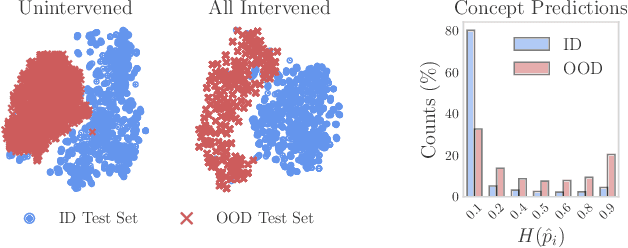

Abstract:In this paper, we investigate how concept-based models (CMs) respond to out-of-distribution (OOD) inputs. CMs are interpretable neural architectures that first predict a set of high-level concepts (e.g., stripes, black) and then predict a task label from those concepts. In particular, we study the impact of concept interventions (i.e., operations where a human expert corrects a CM's mispredicted concepts at test time) on CMs' task predictions when inputs are OOD. Our analysis reveals a weakness in current state-of-the-art CMs, which we term leakage poisoning, that prevents them from properly improving their accuracy when intervened on for OOD inputs. To address this, we introduce MixCEM, a new CM that learns to dynamically exploit leaked information missing from its concepts only when this information is in-distribution. Our results across tasks with and without complete sets of concept annotations demonstrate that MixCEMs outperform strong baselines by significantly improving their accuracy for both in-distribution and OOD samples in the presence and absence of concept interventions.
Deferring Concept Bottleneck Models: Learning to Defer Interventions to Inaccurate Experts
Mar 20, 2025Abstract:Concept Bottleneck Models (CBMs) are machine learning models that improve interpretability by grounding their predictions on human-understandable concepts, allowing for targeted interventions in their decision-making process. However, when intervened on, CBMs assume the availability of humans that can identify the need to intervene and always provide correct interventions. Both assumptions are unrealistic and impractical, considering labor costs and human error-proneness. In contrast, Learning to Defer (L2D) extends supervised learning by allowing machine learning models to identify cases where a human is more likely to be correct than the model, thus leading to deferring systems with improved performance. In this work, we gain inspiration from L2D and propose Deferring CBMs (DCBMs), a novel framework that allows CBMs to learn when an intervention is needed. To this end, we model DCBMs as a composition of deferring systems and derive a consistent L2D loss to train them. Moreover, by relying on a CBM architecture, DCBMs can explain why defer occurs on the final task. Our results show that DCBMs achieve high predictive performance and interpretability at the cost of deferring more to humans.
Neural Interpretable Reasoning
Feb 17, 2025

Abstract:We formalize a novel modeling framework for achieving interpretability in deep learning, anchored in the principle of inference equivariance. While the direct verification of interpretability scales exponentially with the number of variables of the system, we show that this complexity can be mitigated by treating interpretability as a Markovian property and employing neural re-parametrization techniques. Building on these insights, we propose a new modeling paradigm -- neural generation and interpretable execution -- that enables scalable verification of equivariance. This paradigm provides a general approach for designing Neural Interpretable Reasoners that are not only expressive but also transparent.
Efficient Bias Mitigation Without Privileged Information
Sep 26, 2024Abstract:Deep neural networks trained via empirical risk minimisation often exhibit significant performance disparities across groups, particularly when group and task labels are spuriously correlated (e.g., "grassy background" and "cows"). Existing bias mitigation methods that aim to address this issue often either rely on group labels for training or validation, or require an extensive hyperparameter search. Such data and computational requirements hinder the practical deployment of these methods, especially when datasets are too large to be group-annotated, computational resources are limited, and models are trained through already complex pipelines. In this paper, we propose Targeted Augmentations for Bias Mitigation (TAB), a simple hyperparameter-free framework that leverages the entire training history of a helper model to identify spurious samples, and generate a group-balanced training set from which a robust model can be trained. We show that TAB improves worst-group performance without any group information or model selection, outperforming existing methods while maintaining overall accuracy.
Understanding Inter-Concept Relationships in Concept-Based Models
May 28, 2024
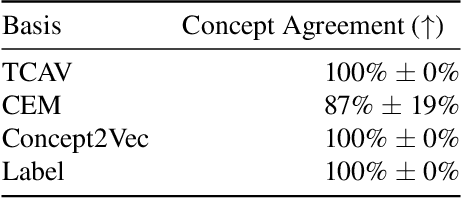

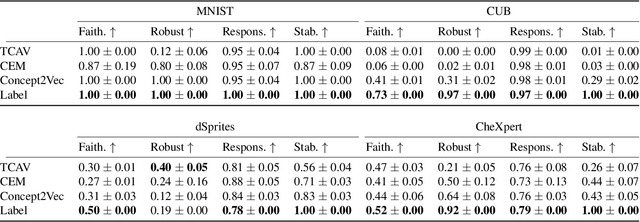
Abstract:Concept-based explainability methods provide insight into deep learning systems by constructing explanations using human-understandable concepts. While the literature on human reasoning demonstrates that we exploit relationships between concepts when solving tasks, it is unclear whether concept-based methods incorporate the rich structure of inter-concept relationships. We analyse the concept representations learnt by concept-based models to understand whether these models correctly capture inter-concept relationships. First, we empirically demonstrate that state-of-the-art concept-based models produce representations that lack stability and robustness, and such methods fail to capture inter-concept relationships. Then, we develop a novel algorithm which leverages inter-concept relationships to improve concept intervention accuracy, demonstrating how correctly capturing inter-concept relationships can improve downstream tasks.
Causal Concept Embedding Models: Beyond Causal Opacity in Deep Learning
May 28, 2024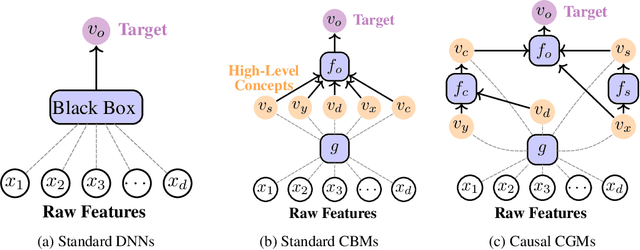



Abstract:Causal opacity denotes the difficulty in understanding the "hidden" causal structure underlying a deep neural network's (DNN) reasoning. This leads to the inability to rely on and verify state-of-the-art DNN-based systems especially in high-stakes scenarios. For this reason, causal opacity represents a key open challenge at the intersection of deep learning, interpretability, and causality. This work addresses this gap by introducing Causal Concept Embedding Models (Causal CEMs), a class of interpretable models whose decision-making process is causally transparent by design. The results of our experiments show that Causal CEMs can: (i) match the generalization performance of causally-opaque models, (ii) support the analysis of interventional and counterfactual scenarios, thereby improving the model's causal interpretability and supporting the effective verification of its reliability and fairness, and (iii) enable human-in-the-loop corrections to mispredicted intermediate reasoning steps, boosting not just downstream accuracy after corrections but also accuracy of the explanation provided for a specific instance.
Do Concept Bottleneck Models Obey Locality?
Jan 02, 2024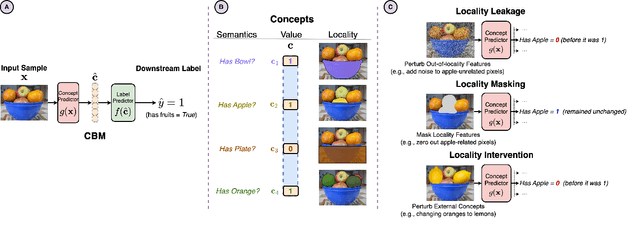
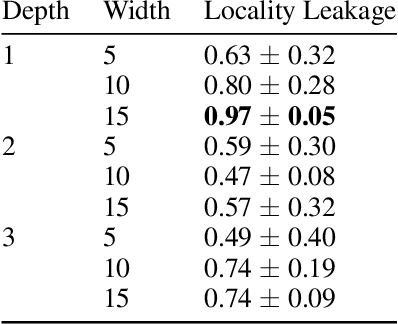

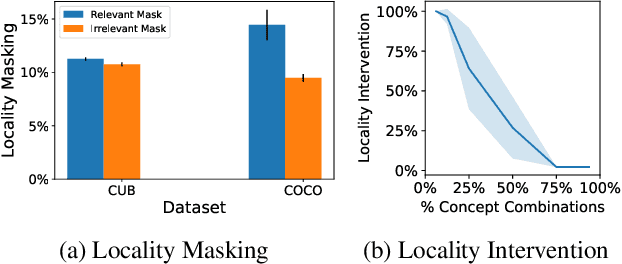
Abstract:Concept-based learning improves a deep learning model's interpretability by explaining its predictions via human-understandable concepts. Deep learning models trained under this paradigm heavily rely on the assumption that neural networks can learn to predict the presence or absence of a given concept independently of other concepts. Recent work, however, strongly suggests that this assumption may fail to hold in Concept Bottleneck Models (CBMs), a quintessential family of concept-based interpretable architectures. In this paper, we investigate whether CBMs correctly capture the degree of conditional independence across concepts when such concepts are localised both spatially, by having their values entirely defined by a fixed subset of features, and semantically, by having their values correlated with only a fixed subset of predefined concepts. To understand locality, we analyse how changes to features outside of a concept's spatial or semantic locality impact concept predictions. Our results suggest that even in well-defined scenarios where the presence of a concept is localised to a fixed feature subspace, or whose semantics are correlated to a small subset of other concepts, CBMs fail to learn this locality. These results cast doubt upon the quality of concept representations learnt by CBMs and strongly suggest that concept-based explanations may be fragile to changes outside their localities.
Learning to Receive Help: Intervention-Aware Concept Embedding Models
Sep 29, 2023



Abstract:Concept Bottleneck Models (CBMs) tackle the opacity of neural architectures by constructing and explaining their predictions using a set of high-level concepts. A special property of these models is that they permit concept interventions, wherein users can correct mispredicted concepts and thus improve the model's performance. Recent work, however, has shown that intervention efficacy can be highly dependent on the order in which concepts are intervened on and on the model's architecture and training hyperparameters. We argue that this is rooted in a CBM's lack of train-time incentives for the model to be appropriately receptive to concept interventions. To address this, we propose Intervention-aware Concept Embedding models (IntCEMs), a novel CBM-based architecture and training paradigm that improves a model's receptiveness to test-time interventions. Our model learns a concept intervention policy in an end-to-end fashion from where it can sample meaningful intervention trajectories at train-time. This conditions IntCEMs to effectively select and receive concept interventions when deployed at test-time. Our experiments show that IntCEMs significantly outperform state-of-the-art concept-interpretable models when provided with test-time concept interventions, demonstrating the effectiveness of our approach.
Interpretable Neural-Symbolic Concept Reasoning
Apr 27, 2023



Abstract:Deep learning methods are highly accurate, yet their opaque decision process prevents them from earning full human trust. Concept-based models aim to address this issue by learning tasks based on a set of human-understandable concepts. However, state-of-the-art concept-based models rely on high-dimensional concept embedding representations which lack a clear semantic meaning, thus questioning the interpretability of their decision process. To overcome this limitation, we propose the Deep Concept Reasoner (DCR), the first interpretable concept-based model that builds upon concept embeddings. In DCR, neural networks do not make task predictions directly, but they build syntactic rule structures using concept embeddings. DCR then executes these rules on meaningful concept truth degrees to provide a final interpretable and semantically-consistent prediction in a differentiable manner. Our experiments show that DCR: (i) improves up to +25% w.r.t. state-of-the-art interpretable concept-based models on challenging benchmarks (ii) discovers meaningful logic rules matching known ground truths even in the absence of concept supervision during training, and (iii), facilitates the generation of counterfactual examples providing the learnt rules as guidance.
 Add to Chrome
Add to Chrome Add to Firefox
Add to Firefox Add to Edge
Add to Edge